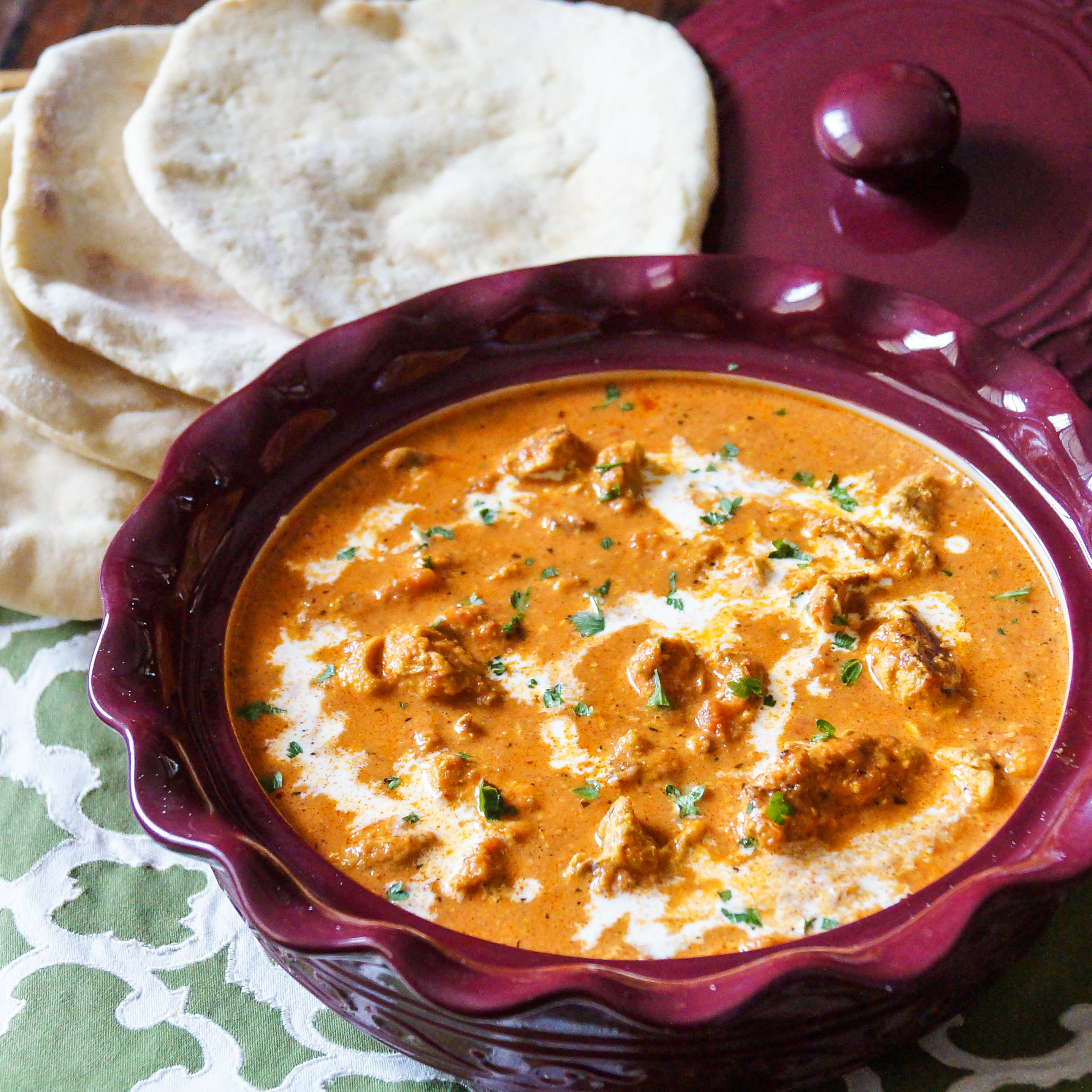Butter Chicken (Murgh Makhani)

Butter chicken (Murgh makhani) is one of the most popular curries in India, England, and throughout the World. It consists of chicken cooked in a (usually) mild smooth creamy sauce with tomato. I like it with some broken cashew nuts in the smooth sauce for texture contrast, but this is not usual, although thickening the sauce with nut paste (generally almond or cashew) is not uncommon.
The recipe here is unspicy and the quantities of spice can be increased considerably if you like more intense flavour. If you like the basic flavour you should experiment with spice quantities and ratios, and also additional spices including aniseed, cardamom, cinnamnon, (powdered) cloves, coriander, and nutmeg.
It is usually mild. A little of what heat there is comes from the black pepper and ginger, but most is from the Cayenne pepper, which consists of powdered hot chilis and may have widely varying amounts of heat. Be careful using it - add small quantities, stir well , taste often and remember that sometimes full heat in the mouth takes ten seconds or more to build up. Cayenne is also known as chili powder in Indian stores, but this should not be confused with the TexMex "chilli powder" which is a blend of spices, including powdered chilis, used for making Chile con Carne - you can use this in Butter Chicken but the flavour will not be quite the same.
INGREDIENTS (Serves 4-6)
- 750 gm Chicken (Skin on / bone in thighs give best flavour, breasts cut into ~2.5 cm cubes are easiest to eat)
- 150-200 gm Butter
- 150-200 ml Cream (15-25% butterfat - not critical, different countries have different names and available grades)
MARINADE INGREDIENTS
- 150 ml Full fat yoghurt
- Juice of one small lime
- 2 tsp Garlic purée, or fresh garlic pressed in a garlic press
- 1 tbs Ginger - fresh root finely grated, or ginger purée, OR, for a sweeter curry:- 1-2 tbs Crystallised ginger, minced or finely chopped
- 2 tsp Paprika
- 2 tsp Cumin powder
- 2 tsp Garam masala
- 1 tsp Black pepper, freshly ground
- ½ tsp Turmeric
- Cayenne pepper to taste (0-2 tsp - depends on how hot you like your Butter Chicken and how powerful your Cayenne pepper is)
Mix the ingredients and use the mixture to marinade the chicken pieces in the refrigerator for a few hours (or longer).
It is possible to use unmarinated chicken when time is limited - in this case the unmixed marinade ingredients, except the yoghurt, are added to the sauce at different times. See below.
SAUCE INGREDIENTS
- 300 gm Onions - (peeled weight) finely chopped
- 100 gm Tomato purée
- 1-2 Chicken stock cubes (to taste)
- 2 tsp Kasuri methi (powdered dried fenugreek leaves - optional)
- 0-4 tsp Nut butter (cashew or almond - peanut is possible but that flavour is more Indonesian than Indian) or powdered almond
- 70 gm Cashews, slightly crushed and broken (optional)
- Water or hard (alcoholic) cider
PREPARATION
Sauté the chicken pieces (keep the marinade, if used, separate) in the butter until they are lightly browned, remove them from the butter and keep warm (~80°C).
Sauté the onions (and the cashews if you are not going to blend the sauce) and garlic & ginger until just beginning to darken. Add the paprika, cumin, garam masala, black pepper, turmeric & cayenne pepper and sauté for another minute or two. Add the tomato purée & chicken stock cube(s) broken up. If you want a smooth sauce you should now add the marinade or the lime juice, blend it in a cup blender, or with a stick blender in the pan, until it is smooth, and then add the cashews (if wanted) and the chicken.
Also add a little cider or water if the sauce is too thick and simmer on the lowest possible heat so that the sauce barely appears to be boiling, or, if it cooked in a casserole, with the lid on in an oven at 130°C (265°F), for 20-30 minutes. Finally stir in the cream and kasuri methi and serve with basmati rice or Indian breads. If you can get fresh fenugreek (methi) leaves you can sprinkle a few, washed and chopped, on top of the curry before serving.
This is a recipe page on the James Bryant (G4CLF) Web-site.
Return to James Bryant's Recipe Index
Return to James Bryant's Home Page

